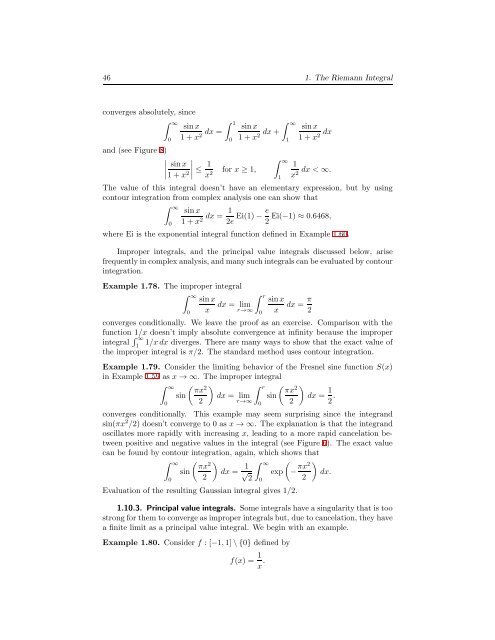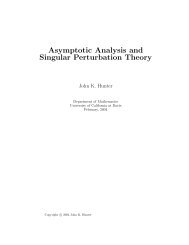The Riemann Integral
The Riemann Integral
The Riemann Integral
You also want an ePaper? Increase the reach of your titles
YUMPU automatically turns print PDFs into web optimized ePapers that Google loves.
46 1. <strong>The</strong> <strong>Riemann</strong> <strong>Integral</strong><br />
converges absolutely, since<br />
∫ ∞<br />
0<br />
∫<br />
sinx 1<br />
1+x 2 dx =<br />
0<br />
∫<br />
sinx ∞<br />
1+x 2 dx+<br />
1<br />
sinx<br />
1+x 2 dx<br />
and (see Figure 8)<br />
∣∣∣∣<br />
sinx<br />
1+x 2 ∣ ∣∣∣<br />
≤ 1 x 2 for x ≥ 1,<br />
∫ ∞<br />
1<br />
1<br />
dx < ∞.<br />
x2 <strong>The</strong> value of this integral doesn’t have an elementary expression, but by using<br />
contour integration from complex analysis one can show that<br />
∫ ∞<br />
0<br />
sinx<br />
1+x 2 dx = 1 2e Ei(1)− e Ei(−1) ≈ 0.6468,<br />
2<br />
where Ei is the exponential integral function defined in Example 1.60.<br />
Improper integrals, and the principal value integrals discussed below, arise<br />
frequentlyincomplexanalysis,andmanysuchintegralscanbeevaluatedbycontour<br />
integration.<br />
Example 1.78. <strong>The</strong> improper integral<br />
∫ ∞<br />
0<br />
sinx<br />
x<br />
dx = lim<br />
r→∞<br />
∫ r<br />
0<br />
sinx<br />
x dx = π 2<br />
converges conditionally. We leave the proof as an exercise. Comparison with the<br />
function 1/x doesn’t imply absolute convergence at infinity because the improper<br />
integral ∫ ∞<br />
1<br />
1/xdx diverges. <strong>The</strong>re are many ways to show that the exact value of<br />
the improper integral is π/2. <strong>The</strong> standard method uses contour integration.<br />
Example 1.79. Consider the limiting behavior of the Fresnel sine function S(x)<br />
in Example 1.59 as x → ∞. <strong>The</strong> improper integral<br />
∫ ∞<br />
( ) πx<br />
2<br />
∫ r<br />
( ) πx<br />
2<br />
sin dx = lim sin dx = 1 2 r→∞ 2 2 .<br />
0<br />
converges conditionally. This example may seem surprising since the integrand<br />
sin(πx 2 /2) doesn’t converge to 0 as x → ∞. <strong>The</strong> explanation is that the integrand<br />
oscillates more rapidly with increasing x, leading to a more rapid cancelation between<br />
positive and negative values in the integral (see Figure 6). <strong>The</strong> exact value<br />
can be found by contour integration, again, which shows that<br />
∫ ∞<br />
( ) πx<br />
2<br />
sin dx = 1 ∫ ∞<br />
)<br />
√ exp<br />
(− πx2 dx.<br />
2 2 2<br />
0<br />
Evaluation of the resulting Gaussian integral gives 1/2.<br />
1.10.3. Principal value integrals. Some integrals have a singularity that is too<br />
strongforthem to convergeasimproper integralsbut, due to cancelation, they have<br />
a finite limit as a principal value integral. We begin with an example.<br />
Example 1.80. Consider f : [−1,1]\{0} defined by<br />
0<br />
0<br />
f(x) = 1 x .
















